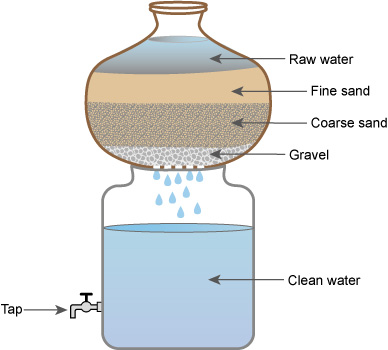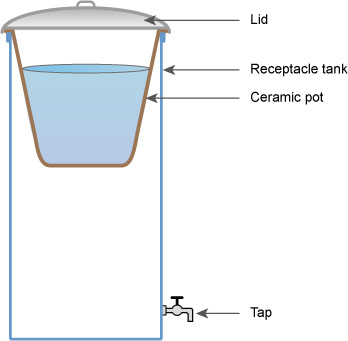10.2.2 Filtration
Filtration is another method of removing suspended particles and is also relatively easy. There are several different methods of filtration that can be used in the home.
Cloth filtration
Cloth filtration (Figure 10.5) is cheap, easy to carry out and a common water treatment technique. Pouring turbid water through a piece of fine, clean cotton cloth will remove larger contaminants and a certain amount of suspended solids. It is better to use a used, rather than new, piece of cloth.
Why do you think a used, washed piece of cloth is better for filtration?
Once cloth has been washed several times, the gaps between the fibres it is made from are smaller and therefore better for trapping any solid matter.

The steps in cloth filtration are as follows:
- Use a large cloth, preferably made of finely-woven cotton. Fold the cloth at least four times so that there are multiple layers of fabric, and place this over the opening of the storage vessel.
- The cloth, once folded, must be big enough to easily cover the opening of the receiving water container.
- Place the cloth over the mouth of the container.
- Fasten the cloth securely around the rim of the opening, using string. If reusing the cloth, always use the same side up each time.
- Pour the water through the cloth, into the container.
- Wash the filter cloth after each use, with a final rinse using cloth-filtered water, and then leave the cloth in the sun until it is dry.
- Clean the cloth regularly using detergent, and use a new piece of cloth as soon as there are any visible tears or holes.
- Always keep filtered water separate from non-filtered water.
Household sand filtration
A household sand filter can usually be made from locally available and inexpensive materials like clay pots or barrels. They are simple and easy to use. One such system consists of a pot and a storage vessel (Figure 10.6).

The details of the system are as follows:
- The bottom of the pot is perforated (has tiny holes in it).
- The pot contains layers of gravel (about 5 cm deep), coarse sand (about 5 cm deep) and fine sand (about 10 cm deep).
- Water is poured in at the top and, as it passes through the layers, any particles within it are filtered out.
- Clean water drips into the storage container.
- The storage container should have a tap to enable the clean water to be drawn out easily and safely.
- The sand and gravel should be changed when the rate of filtration starts to slow; at a minimum it should be changed every two to three months.
Ceramic filtration
For ceramic filtration, a water filter in the form of a ceramic pot can be made using clay, sawdust or rice husks, and a plastic bucket. The pot is made by mixing clay with the sawdust or rice husks, forming it into a flowerpot shape and then firing it in a kiln. The sawdust or rice husks burn away, leaving tiny pores in the ceramic through which water can be filtered. The small pore size of the ceramic material traps the particles and most micro-organisms.
To use the filter, the pot is inserted into a container so that its lip prevents it from slipping into the container (Figure 10.7). The raw water is then poured into the ceramic pot. Cleaned water percolates out of the pot and is collected in the container below. A tap on the container allows water to be drawn out.
The filter is cleaned by gently scrubbing the surface, and it is recommended that the filter be replaced every 1–2 years, as fine cracks not visible to the naked eye may have developed.

10.2 Methods of household treatment of water
